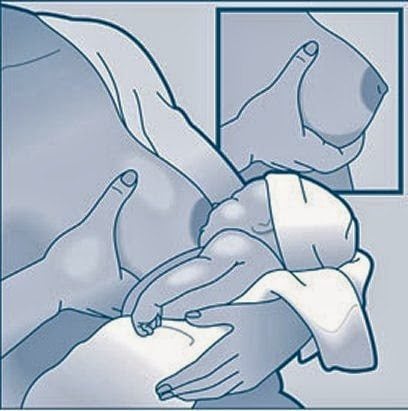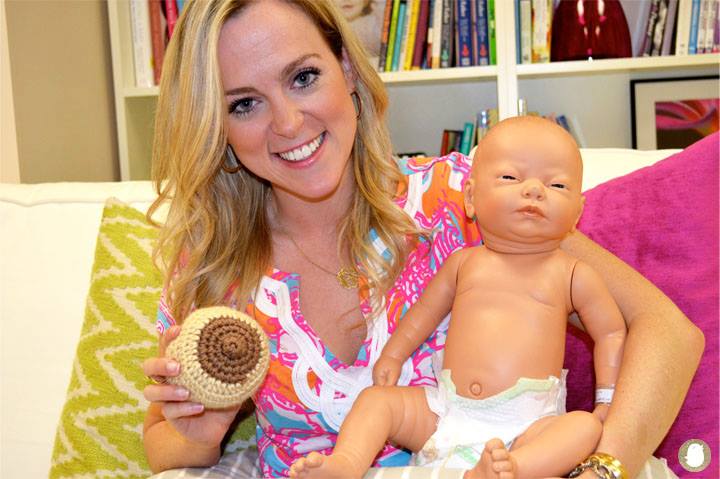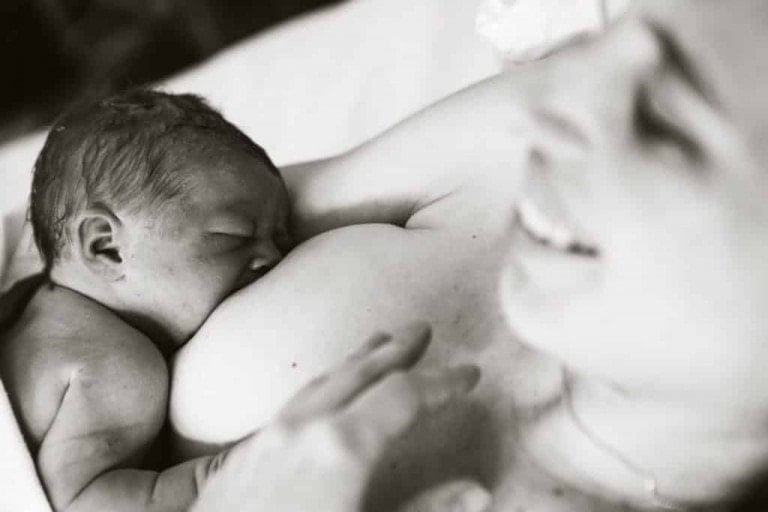Breastfeeding can be tough. But half of the battle is getting a good latch. I wanted to share some tips and tricks to getting the best latch when breastfeeding your baby. As a certified DONA postpartum doula, breastfeeding is one of the main topics new parents ask me about. The following tips and proper positioning will help you achieve a good/deep latch with your baby. Here are the things I am looking for when helping a momma with breastfeeding.
First, you’ll want to find a comfortable chair or place to sit when you’re getting ready to breastfeed. Make sure that it provides good back support. If you don’t feel comfortable or have good back support, bring some pillows with you to help with this. Another thing that you may want to consider having is a stool for your feet. This is because it helps with proper posture and keeps you from straining your neck and shoulders. Having good posture and being in a comfortable position are important.

The next thing that you’ll want to have is a breastfeeding pillow. There are many available options—for example, a Boppy pillow or a My Brest Friend nursing pillow. If you don’t have a breastfeeding pillow, you can use pillows from around the house to help with the baby’s position. But I will say that a good breastfeeding pillow is a nursing essential because it can really help make things easier, more convenient, and more comfortable.


Now that you’re comfortable and all set to go, I will share my six rules for getting the best latch.
6 Rules for Getting the Best Latch
Rule #1: Tummy to Tummy


When baby is ready to eat, you want to position baby’s tummy to mommy’s tummy. There are many different breastfeeding positions that you can feed your baby. The main ones are the cradle hold, the cross-cradle hold, the football hold, and side-lying.

In these positions, you want to ensure that you have one hand or arm supporting baby’s neck and the other hand supporting your breast. Holding your breast can help get more of your breast/bottom of your areola into your baby’s mouth. We call these holds the C-hold or the U-hold.


Rule #2: Nose to Nipple

Many parents I have worked with have their baby higher than the nipple should be. I understand why they think this is right since they try to get their baby’s mouth level with the mother’s nipple. (See below.)

However, we want mom’s nipple to be level with baby’s nose. This will help baby lift their head and chin and open their mouth wider for a better latch. This helps put mom’s nipple in the right place in baby’s mouth to make it more comfortable for her.

Rule #3: Chin to Breast

If your baby’s chin is down to their chest, it will be more difficult for them to open wide and get the best latch. We want to ensure that baby’s chin is up to mom’s breast. Once you have their chin to your breast and your nipple is to their nose, you will start tickling their nose and upper lip with your nipple, which will help stimulate baby’s mouth to open. Once baby’s mouth has opened wide, and their tongue is down, you are ready for rule number four!
Rule #4: Baby to You, Not You to Baby

When baby has his mouth open wide, be sure to bring baby to you and not lean over to bring your breast to baby. I can’t tell you how many mothers I’ve seen lean forward and shove their breast in their baby’s mouth as soon as it opens.

Remember, posture is important! If you have poor posture, it can affect your let-down and how much milk you are giving your baby. The more comfortable and relaxed you are during breastfeeding, the better.
Rule #5: Nipples to the Roof

I know that sounds like a silly rule. What I mean is, you want to have your nipple at the roof of your baby’s mouth and have more of the bottom of your areola in their mouth. When your nipple is at the roof of their mouth, it hits their soft palate. When you have the nipple dead center in their mouth, having the areola all around it in their mouth, your nipple will not be at their soft palate, which can cause you to feel pain and potentially cause cracked nipples.

If you can tell that your nipple isn’t in the right place, you want to break the latch suction before removing the baby. Otherwise, baby is going to pull your nipple with them. Ouch! The way to break suction is to put your finger in the crease of baby’s lips and your breast and press on your breast to break the suction. Then you can move baby and start all over again!

Rule #6: Fish Lips
Another thing you want to check is that baby’s lips are flanged out. If they aren’t, you can use your thumb to gently push down baby’s chin to widen their latch and push out their bottom lip. Every time I have done this while a baby was latched, mothers have told me that it helped and made the latch more comfortable.


These are my six rules on how to get the best latch for baby! Breastfeeding shouldn’t hurt, so if it does hurt, try these steps to help with baby’s latch. If you need more support, contact your local IBCLC for in-person support.






























